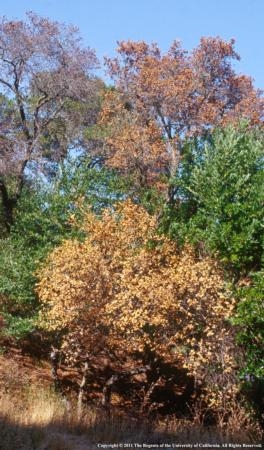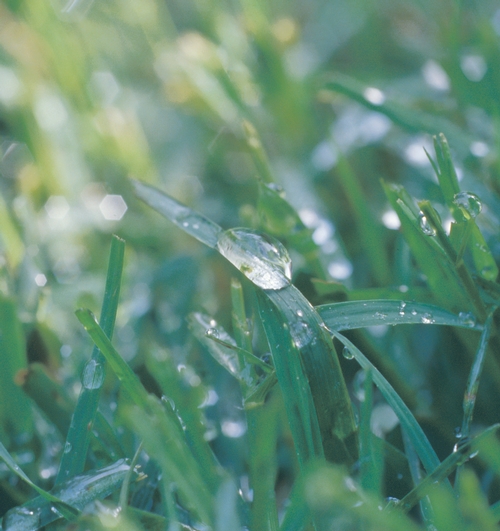UC Blogs
Olive Tree: Beauty and Bane
Do you have an olive tree, Olea europaea, in your landscape? We do - a 'Kalamata' olive. It's a beautiful evergreen tree that, once established, requires very little water. The pollen can be highly allergenic. Ten years ago, we brought it home from the Vacaville Home and Garden Show. It was a spindly little stick, not more than ten inches tall from root ball to tip. We were excited at the prospect of harvesting our own olives and curing them with a method my husband read about that used only water and salt instead of lye. Let me say, LOTS of water and salt. We planted it in the back portion of our vegetable garden, about two feet from the fence line. No, I was not a master gardener ten years ago, or I would have known to plant it farther from the fence.
Over the years, it's grown to about 20+ feet tall. Since then, that vegetable garden has been relocated to accommodate a swimming pool, the size of which was dictated by the location of the olive tree. My husband and I are out there pruning the tree a few times a year to keep it from hanging over the neighbor's yard. In the spring, the yellow pollen from the tree coats the patio and chairs in a thick yellow dust. From now until January, I am constantly picking up dropped olives to alleviate staining of the concrete. And the olives we were going to cure? Haven't eaten a single one. On the upside, the tree provides a terrific area of shade to sit under, and lends a distinctively Mediterranean atmosphere to the backyard. It is a beautiful tree.
So what have I learned from this tree? Two feet between a tree and a fence is nowhere near enough. Curing olives takes time and patience. Even though olive trees grow well in Solano County, don't plant them near a pool!
Don't put a pool next to an olive tree.
Coming Right at You
It's not often you see a monarch butterfly and a digger bee in the same photo. Such was the case on a recent visit to a lantana patch at a west...

Monarch butterfly nectaring lantana, while a digger bee, Anthophora urbana, heads toward it. (Photo by Kathy Keatley Garvey)
Threecornered Alfalfa Hopper Update
The threecornered alfalfa hopper is a green, wedge-shaped insect about the size of a Lygus bug. These leafhopper pests have piercing-sucking...
Sudden oak death expands in San Francisco Bay Area
Diseased trees were even found in Golden Gate Park, where there is no obvious source of the pathogen, such as nurseries or wildland.
"It's puzzling that we found it there because it's a totally urban environment, and I really didn't expect it. It shows how complicated and adaptable this organism is," said Matteo Garbelotto, UC Cooperative Extension specialist in the Department of Environmental Science, Policy and Management at UC Berkeley. "The area doesn't have a lot of oaks, so I'm not worried about oaks there, but I'm worried about other plants being infected and, of course, people carrying it on their shoes."
UC Cooperative Extension Advisors Help Develop the National Standard for Landscape Water Needs
The American Society of Agriculture and Biological Engineers (ASABE) has appointed Dennis Pittenger, area environmental horticulturist for Southern California, and David Shaw, farm advisor in San Diego County, to serve on its panel of experts to develop a national standard for determining the water needs or urban landscapes. Once developed, the standardized procedure will be the national, science-based method employed by landscape management professionals, water agencies and local jurisdictions that need to meet or implement landscape water conservation mandates.
ASABE selected Pittenger and Shaw based on their extensive research on estimating water needs of non-turf landscape plants and their history of providing education programs for green industry professionals who manage landscape irrigation.
"The past and current approaches have not been reliable in the numbers they produce, and they give users a false sense of precision while failing to achieve the intended conservation of water. The new method will be simple to use and based on 20 years of research findings," said Pittenger. "It is a great opportunity to see research-based information play an important role in public policy and standards adopted by the industry," he added.
ASABE is a 9,000-member international scientific and educational organization dedicated to the advancement of engineering in agriculture, food and biological systems. It is recognized worldwide as a standards developing organization with more than 240 standards in current publication.
For more information on the development of the standard procedure for landscape water needs, please contact Dennis Pittenger at (951) 827-3320, dennis.pittenger@ucr.edu.
For information on UC Cooperative Extension's offerings in environmental horticulture, please visit UCCE-LA's website.
As part of the University of California, Cooperative Extension was established in 1914 to connect local communities to their state's land grant university. An office in each county in California responds to the changing needs of its local populations, designing and carrying out research-based programs in the areas of food, health, agriculture, horticulture and the environment.



